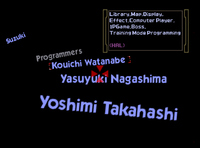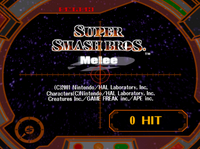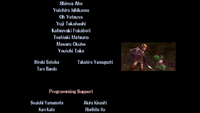Credits
The Credits are a feature shown at the end of a game that list the cast and staff members who worked on it. Super Smash Bros., Super Smash Bros. Melee, Super Smash Bros. 4, and Super Smash Bros. Ultimate has this feature. Super Smash Bros. Brawl's has a similar feature, the Character Roll Call, except it lists the characters, items and trophies instead. Standard ending credits do appear in Brawl after completing the Subspace Emissary, though in a different format than its predecessors.
In Super Smash Bros.
After beating 1P Game, the credits will slowly pass by. When shooting a staff name, the screen will pause long enough to let the player read the name of the staff member. By pressing Start, the credits will speed up and will not pause if the player shoots them. If the player presses the B Button, then the credits will pause; hitting B again on a name will show the staff member's contributions to the game. Pressing the A or Start buttons or pressing B on a blank space will resume the credits.
If a secret character is not unlocked yet, anything relating to that character will appear as "?????" in the information box; this is presumably done to prevent spoilers.
A remix of the track that plays in the credits from SSB appears as an unlockable CD in Brawl.
In Super Smash Bros. Melee
After beating Classic Mode, Adventure Mode or All-Star Mode, the credits will appear as they do in Super Smash Bros.. However, the credits go by much faster, have different paths that they can move, and do not pause when shot. The background is also different; whereas the original game had a blank, black background, Melee 's credits feature what appears to be space, as the player travels around tunnels, a giant Smash logo, and some types of futuristic architecture. As in the previous game, the player can press Start to speed up the credits, as well as use B to pause the action. The game also displays how many credits they successfully hit at the mode's conclusion, though this score is not saved and has no impact on gameplay.
Some credits, such as the voice actors for secret characters, are not immediately available, and only become present when these unlockables are obtained.
Due to the presence of the localisation staff, a higher score can be attained in PAL regions than NTSC regions.
The presence of a score counter in the credits led to the formation of a hoax that was later debunked.
Music
Unlike in Super Smash Bros., the ending credits in Melee has separate music for each character. Each character has a song for their credits theme based on their own universe.
Listed below are the tracks that play for each character.
In Super Smash Bros. Brawl
Unlike the previous two games, where the completion of the primary 1P modes resulted in the player seeing the end credits, the ending credits in Brawl only play when the Subspace Emissary is completed and after Tabuu is defeated in subsequent playthroughs of the same Subspace Emissary file. The ending credits in Brawl are drastically different than the ending credits of Melee, and is more similar to Smash 64. The credits scroll in a more traditional manner, from the bottom of the screen to the top on a black background, and some boxes will also appear during the credits that show different short clips of some movies from The Subspace Emissary. Using the GameCube controller's C-Stick or the Classic Controller's right control stick, the player can rotate the credits. The shooting minigames from Smash 64 and Melee did not return in Brawl's credits.
The music that plays during Brawl's ending credits is Credits.
At the end of Classic Mode and All-Star Mode, the player instead views the Character Roll Call, which replaces the Ending Credits minigame for these modes.
In Super Smash Bros. 4
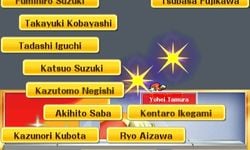
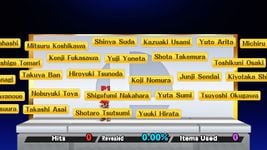
Right: The credits in Super Smash Bros. for Wii U.
The credits return to Classic Mode in both the 3DS and Wii U versions and All-Star Mode, where unlike in the previous games, instead of shooting the names, the player can use their fighter to attack the names. In the background there is a large panel with that fighter's ending image. However, the photo is hidden by a white texture, and must be uncovered. As the player attacks the names, the hit rectangle flies to the background, removing part of the white texture and revealing chunks of the ending image. The player can speed up the credits by pressing the Start button if they wish, but then can not attack the credits while they are fast-forwarded. The player is awarded 1 Gold per 1% of the image. Also, if 99.99% of the image is revealed, the game may choose to automatically round the score up to 100%. Therefore the most a player can receive is 100 Gold.
The background panel does not stay in place, slowly moving up and down throughout the minigame, requiring the player to adjust their attacks accordingly.
In the Wii U version, some of the credits scroll left, instead of all of them scrolling up. As a result, it is more difficult to get a perfect score in the Wii U version than the 3DS version; to alleviate this, Screw Attacks, X Bombs, Super Mushrooms, and Smart Bombs that do not hurt the user can float by on balloons, which can be popped to release the item for use.
The credits music, again entitled Credits, consists of a medley of main themes from all four games of the Super Smash Bros. series, arranged by Torine.
Version 1.0.6 of Smash 4 added additional credits for post-release content, such as voice actors for downloadable characters. If such content is available, then extra credits will appear in the minigame, granting more opportunities for players to complete the image.
In Super Smash Bros. Ultimate
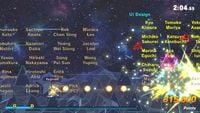
The credits return after beating Classic Mode. Unlike the previous installments, it is a scrolling shooter that changes perspective as the player progresses. The player controls their fighter equipped with a Super Scope to fly around and shoot the names. Players can shoot an explosive item which triggers a Smart Bomb-like explosion to hit nearby names. A score is displayed based on names that were hit and a progress bar with rewards is displayed on the bottom left corner. The progress bar will move towards the rewards as the player shoot the names at five different point thresholds, starting at 100,000 and continuing on until 1,500,000 points. The background is set in space. The camera changes angles when the player progresses in the credits. The player can speed up the credits like in previous Smash Bros. games. After the credits, the fighter's ending image is shown along with the score, but this time, the clear movie scenes don't appear anymore after the final results. Like in Super Smash Bros. Melee and Brawl, each character has their own separate music based on their own universe.
The credits also appear after completing World of Light and it displays the names. It is set in a black background and the shooting credits game is not in the World of Light's credits.
Listed below are the tracks that play for each character on Classic Mode's credits.
| Character | Song |
|---|---|
| Mario | Super Mario Bros.: The Lost Levels Medley |
| Donkey Kong | Donkey Kong Country Returns (Vocals) |
| Link | Title Theme - The Legend of Zelda |
| Samus | Ending - Metroid |
| Dark Samus | Multiplayer- Metroid Prime 2: Echoes |
| Yoshi | |
| Kirby | Staff Credits - Kirby's Dream Land |
| Fox | |
| Pikachu | Road to Viridian City - Pokémon Red / Pokémon Blue |
| Luigi | |
| Ness | Smiles and Tears |
| Captain Falcon | |
| Jigglypuff | |
| Peach | |
| Daisy | |
| Bowser | King Bowser - Super Mario Bros. 3 |
| Ice Climbers | |
| Sheik | |
| Zelda | |
| Dr. Mario | |
| Pichu | |
| Falco | |
| Marth | Fire Emblem Theme |
| Lucina | |
| Young Link | |
| Ganondorf | |
| Mewtwo | |
| Roy | |
| Chrom | |
| Mr. Game & Watch | |
| Meta Knight | |
| Pit | Underworld |
| Dark Pit | |
| Zero Suit Samus | Theme of Samus Aran, Space Warrior |
| Wario | |
| Snake | MGS4 ~Theme of Love~ |
| Ike | |
| Pokemon Trainer | |
| Diddy Kong | |
| Lucas | |
| Sonic | |
| King Dedede | |
| Olimar | |
| Lucario | |
| R.O.B. | |
| Toon Link | |
| Wolf | |
| Villager | |
| Mega Man | |
| Wii Fit Trainer | Main Menu - Wii Fit |
| Rosalina & Luma | |
| Little Mac | |
| Greninja | |
| Palutena | |
| Pac-Man | |
| Robin | |
| Shulk | |
| Bowser Jr. | |
| Duck Hunt | |
| Ryu | Ryu Stage |
| Ken | Ken Stage |
| Cloud | Fight On! |
| Corrin | |
| Bayonetta | Let's Dance, Boys! |
| Inkling | |
| Ridley | VS Ridley |
| Simon | Bloody Tears/Monster Dance |
| Richter | Dracula's Castle |
| King K. Rool | Gang-Plank Galleon |
| Isabelle | |
| Incineroar |
Trivia
- In the PAL version of Melee, at the end of the credits, it will say "Certain characters and items from Perfect Dark and Donkey Kong Country 2. Donkey Kong Rap music based on original Donkey Kong 64 music courtesy of Rare Ltd."
- In SSB4, if a character from the Mario series is used in the credits sequence, the font used for "Congratulations" changes to a Mario themed font.
- This also applies to its spin-off universes Donkey Kong and Wario, but not Yoshi.
- Similarly, a Street Fighter-themed font is used for Ryu, and a font in the style of the Final Fantasy logo is used for Cloud.
- In Smash 4 and Ultimate, attacking the company logos causes a unique sound: "BANDAI NAMCO Games" and "BANDAI NAMCO Studios" causes a Pac-Man eating sound effect, "Nintendo" causes a Game Boy startup sound effect, and "Sora" causes a crowd cheer.
- In Smash 64 and Melee, the Pokémon released from Poké Balls do not have their voice actors credited. In the PAL version of Brawl, this is true of their French and German actors.
